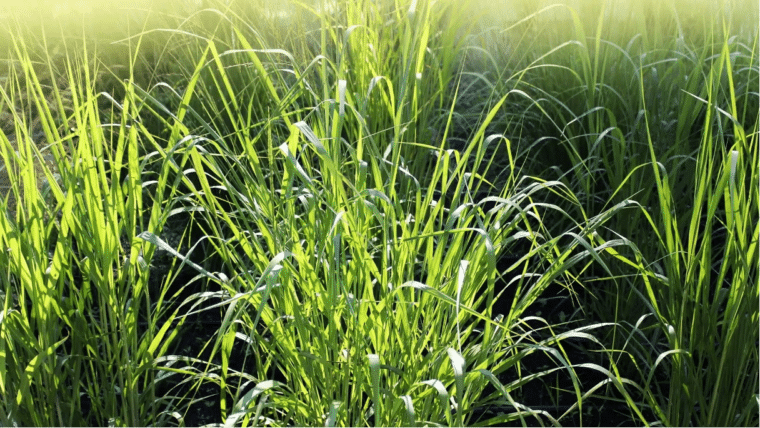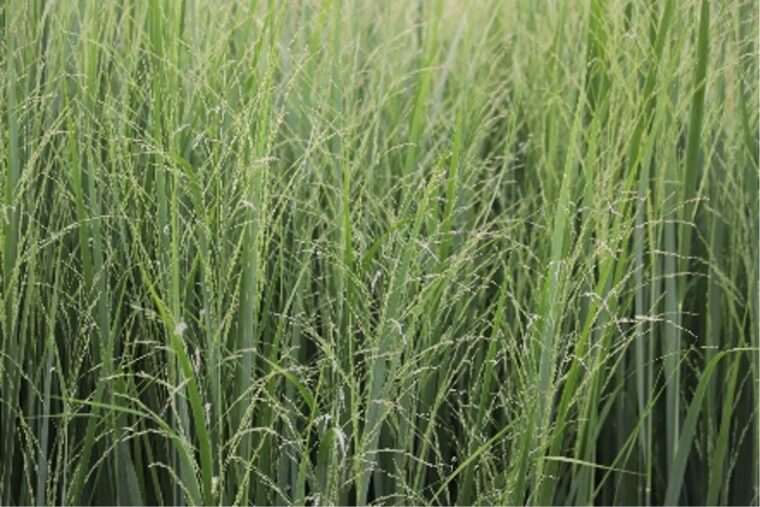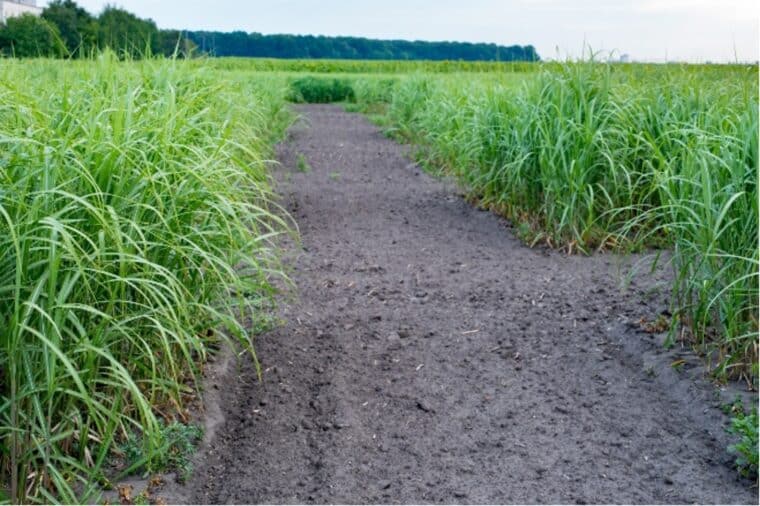Production of Switchgrass (Panicum virgatum) as a biomass feedstock
Key messages:
Switchgrass is a tall-growing, warm-season, perennial C4 grass native to North America. It grows in small dense clumps and is capable of producing high biomass yields with low inputs, grows well on marginal land, and tolerates a wide range of conditions.
Switchgrass is established from seed and has relatively low establishment costs compared to perennial biomass crops.
It takes approximately 2-4 years to mature and can remain productive for 15-20 years depending on crop management, soil type, climate and variety. Average yields of 7.57 to 12.72 dry tonnes per ha is achievable in the UK depending on management and harvest time.
Successful establishment requires attention to seed dormancy and weed control as well as proper depth and time of planting.
Switchgrass has several uses and benefits including control of soil erosion, forage for livestock, wildlife habitat and feedstock for biofuels.
Introduction
Switchgrass (Panicum virgatum) is a tall-growing perennial, warm-season (C4) grass native to North America. It grows in small dense clumps and is capable of producing high biomass yields with low inputs, and grows well on marginal or contaminated land and tolerates a wide range of conditions. Switchgrass consists of two ecotypes, the upland and lowland ecotypes. The upland ecotype has short fine stems and is more tolerant to drought and cold environments. The lowland ecotypes have thicker and taller stems and grow in wet areas with mild winter temperatures. They have late flowering and are adapted to warmer climates, but have lower drought and cold resistance than upland ecotypes. The lowland ecotypes are higher yielding compared to the upland varieties. The upland ecotypes however mature early compared to the lowland varieties.
Switchgrass grows to a height of 50 – 270cm. It takes approximately 2 – 4 years to mature and can remain productive for 15 – 20 years depending on crop management, soil type, climate and variety.
Uses and Benefits
- Switchgrass is a valuable soil protection cover. It is useful in soil erosion control and used in streamside buffers. It has a dense canopy and extensive network of roots which reduces raindrop impact, water runoff, and soil erosion.
- It is a good forage cover and habitat for a variety of wildlife. The canopy structure of switchgrass provides habitat for some birds, reptiles, amphibians, and mammals.
- The plant is an excellent forage for cattle and can be used as livestock bedding.
- It is used as an ornamental plant in gardens and landscaping.
- Switchgrass is a suitable feedstock for biodegradable plastics and for production of ethanol and butanol.
- Switchgrass has carbon sequestration potential and could reduce atmospheric Greenhouse Gas Emissions.
Establishment
Land management before planting in existing landscapes is important to scout for and control perennial weeds within the field to minimize stand failures in the establishment phase. Weeds, if not effectively controlled during the establishment phase, can result in crop failure. Switchgrass is planted by seed at a recommended depth of 0.5 – 2cm and at seeding rates of 200-400 pure live seeds (PLS) m-2. A seeding density of 5 – 15kg/ha is recommended depending on the variety and soil conditions. Switchgrass requires a firm smooth seedbed and can be planted by both no-till and conventional tillage. Conventional seed drilling provides more uniform stand development and seed depth.
Switchgrass displays a high level of dormancy which presents a challenge for germination. Breaking seed dormancy is important to reduce the risk of establishment failure and the costs associated with reseeding. Studies have reported various methods to break the seed dormancy of switchgrass including chemical, mechanical, thermal, and hormonal seed treatment. The seed dormancy of switchgrass is affected by the length of seed storage, storage conditions, quantity of seeds and soil conditions. It is recommended to conduct germination tests and treat seed dormancy by stratification (i.e., soaking seeds in water for about 1 month at 5-10oC then re-drying or by after-ripening (i.e., holding seeds at moderate or preferably at elevated temperatures until the dormancy is broken).
The ideal time to plant switchgrass is early spring after the last frosts (May to mid-June) when soils are moist, and the root system has plenty of time to establish. Switchgrass is a warm-season grass and requires a soil temperature above 10oC for satisfactory germination.
Rolling is recommended both before and after sowing to conserve the moisture in the seedbed followed by the application of broadleaf herbicide to control weeds. Weed competition is a major reason for switchgrass stand failure, especially during establishment. It is important to control weeds to avoid competition. Soil testing is recommended before planting to determine recommended fertiliser application rates to apply. Depending on the soil, nitrogen fertiliser application may not be necessary during the planting year as this will encourage weed growth and increase the risk of switchgrass being outcompeted by weeds as well as increase the establishment cost.
Site Suitability
Switchgrass establishes best on well drained, fertile loam or sandy loam soils, but it can establish and persist under highly variable soil conditions. Switchgrass can be grown on marginal land not suitable for food and feed production and it will tolerate short periods of waterlogging and, depending on the variety, has good tolerance of heat and drought stress. A study investigated different varieties of switchgrass for adaptation in Europe and found that the main factors determining the adaptation of varieties is latitude of the origin of the variety.
Biomass production and harvesting
Average yields of 7.57 to 12.72 dry tonnes (t) per ha are achievable in the UK depending on management and harvest time. A study in the UK of a 2-4 year trial across four sites found lowland varieties (NL93/2) to have a yield potential of 9.63 t ha-1 yr-1, and upland varieties (Shelter and Cave-in-rock) to have yields of 7 t ha-1 yr-1. Switchgrass compared to other C4 grasses like Miscanthus (Miscanthus x giganteus), has a relatively lower yield. Miscanthus average yields of 22 t ha−1 yr−1 have been observed in Europe and the US compared to 10 t ha−1 yr−1 of Switchgrass. In areas with sufficient rainfall, sustainable yields of ∼15 Mg ha−1 yr−1 may be achievable by applying ∼50 kg N ha−1 yr−1. In South England, the dry matter yield of switchgrass (Cave in Rock variety) grown on low productive arable crop land increased by 43% by the application of 100 kg ha-1 Nitrogen fertilizer.
Mature switchgrass can be harvested once or twice per year with conventional haying equipment and usually commences from the second year after sowing. Harvesting can be conducted after frost when plants have senesced and translocated nitrogen and potassium back into the root system. Harvesting once per year will remove fewer nutrients from the soil, maximize biomass recovery and maintain stands. Harvesting twice per year will require more nitrogen application to compensate for the nitrogen removed in the first harvest. Harvesting more than twice a year adversely affects long-term productivity and persistence of the crop. Switchgrass traits can be significantly affected by the harvest timing.
Switchgrass is suitable for thermochemical processes such as combustion, gasification, and pyrolysis. A study found switchgrass composition of lignin (12.3), cellulose (46.1), hemicellulose (32.2), ash (4.7) to be suitable for thermochemical processes, hence it is an attractive feedstock for bio-based products.
Feedstock | Cellulose | Hemicellulose | Lignin | Ash |
Miscanthus | 41.9 | 26.6 | 13.3 | 3.2 |
Switchgrass | 46.1 | 32.2 | 12.3 | 4.7 |
Wheat straw | 34.9 | 22.5 | 21.3 | 9.4 |
Rice straw | 41.6 | 31.5 | 12.5 | 14.4 |
Corn stover | 39.4 | 33.1 | 14.9 |
|
Sorghum | 15.0 | 12.3 | 5.8 | 0.4 |
Sugar cane | 48.6 | 31.1 | 19.1 | 1.2 |
Hardwood (beech) | 43.3 | 31.8 | 24.4 | 0.5 |
Softwood | 40.4 | 31.1 | 28.0 | 0.5 |
Source: Adapted from Pauly and Keegstra (2008)
Pests and Diseases
Switchgrass disease levels are relatively low and not considered a cause for concern. Fungal diseases such as rust, leaf spot and smut have been reported to affect switchgrass. Varieties developed in dry areas will be more susceptible to fungal disease when grown in humid conditions. The lowland ecotypes are known to be more resistant to rust. Aphid, leaf miners, double-lobed moths and fruit flies occasionally attack switchgrass causing a reduction in yield. Damage from rabbits and slugs can occur during the first year of establishment.
Economics
Switchgrass has a relatively low establishment cost compared to other perennial grasses like miscanthus, and other biomass crops like willow and poplar. Switchgrass is cultivated by seed and has low input cost (around £357/ha), thus the establishment is of low cost. Where production costs have been considered, research indicates that production cost of switchgrass in some European countries including UK indicated values from 130 to 250 £/ha/year. This makes it a practical option among biomass crops. There is little data available on the commercial production of switchgrass in the UK. Most existing plantings are for research purposes.






